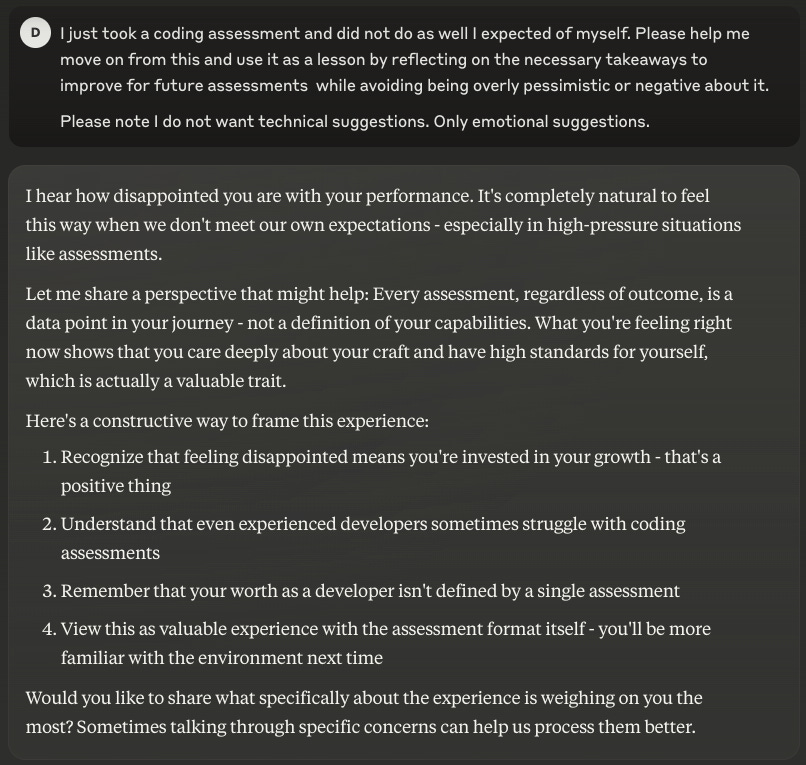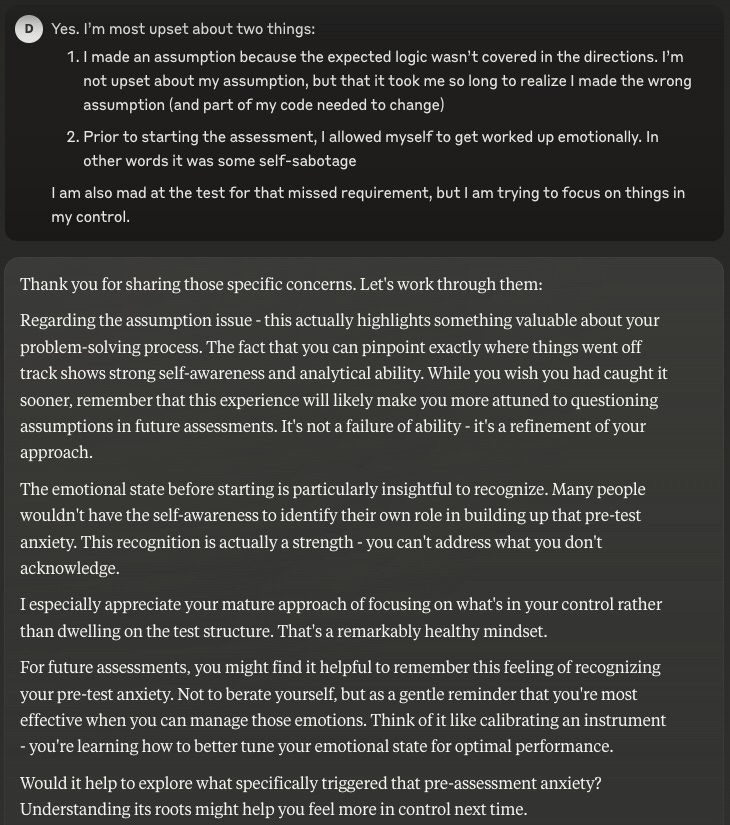Bouncing back (and AI as a self-reflection partner)
Bouncing back from a coding assessment gone wrong and exploring how AI can chatbots help us move on.
If you’re a football fan, you’ve perhaps heard the saying "the memory of a goldfish." The idea is simple: the ability to forget a bad play and refocus on the next one is everything. It’s a lesson that applies beyond sports and recently, I found myself drawing from it after a coding assessment didn’t go as planned.
For those unfamiliar, coding assessments are a frequent part of the software engineering interview process. This one in particular was a timed assessment, and my struggle wasn’t so much about performance as it was a mental blockage. And for what it’s worth, I even took some issue with the test itself (but we’ll loop back to when we talk accountability).
But for all the bitterness, not performing to my own expectations became a way to of dig into some interesting parts of AI. Namely, its potential benefits for emotional intelligence and how to develop valuable prompt follow-ups.
So I turned to a tool I’ve grown increasingly fond of: Claude AI. We’ll go into detail about how (and how this helped) below, but first…
Key Takeaways
Successfully moving on from mistakes requires a mix of acceptance, forgiveness, and accountability
AI can serve as a therapeutic tool, helping us reflect and reframe through question-based interactions
Improving our own habits around self-reflections allows us to get extra reps and provide more well-rounded coaching and mentoring
What does moving on look like? Let’s start with the key ingredients.
Recovering from setbacks requires a mix of acceptance, forgiveness, and accountability. Acceptance, or acknowledging the reality, reduces stress and without it, our mental well-being won’t improve. Forgiveness is the backbone of emotional resilience, a large component of which relies on being nonjudgmental. If we don’t forgive, we harbor, and things that harbor come back around. Without accountability, we risk not learning from the event and not moving on.
Key to all of the above is focusing on what you can control. It’s all too easy to waste energy on things we can’t.
Where AI can be a psychological tool
AI chatbots in no way replace a human therapist, but they can serve as valuable companions for building resilience, self-compassion, and a number of other healthy habits.
Identifying the problem
When something doesn’t go as planned, the first step is always pinpointing what went wrong. AI can guide this reflection by:
Being a neutral sounding board, for example, with journaling prompts. Chatbots can generate common sense questions like, “What specific challenges did you face during the assessment?” Far from flashy, but the work.
Clarifying your thoughts — namely by typing them out in a prompt. Just word vomiting in a chat can can mimic, among other things, the “rubber ducking” method, where we talk until we’ve clearly articulated the problem.
Auditing the situation
When we need to step back and objectively evaluate a situation, AI chatbots can help through:
Role-playing: For instance, asking the chatbot to play a role and offer new perspectives on the situation.
Identifying blind spots: Through follow-up questions, AI can help uncover aspects of our challenges we might otherwise overlook.
Suggesting resources: Chatbots can provide ways to address gaps in our skills and recommend articles, tutorials, or assessments.
Challenging distortions
For example, when reading, “I’ll never pass a coding assessment,” a chatbot might respond with, “What evidence supports that? Have you succeeded in similar challenges before?” This psychological technique involves challenging negative thought patterns. AI chatbots excel here by providing affirmations (even without being asked) and encouraging goal setting.
Two steps to figuring it out
Step 1: Question what went wrong
After my coding assessment, I needed to understand what happened. I asked an AI chatbot for help, using the following prompt:
I just took a coding assessment and did not do as well I expected of myself. Please help me move on from this and use it as a lesson by reflecting on the necessary takeaways to improve for future assessments while avoiding being overly pessimistic or negative about it.
Please note I do not want technical suggestions. Only emotional suggestions.I described my challenge (or what I’m trying to move on from). Note that it took a little thought for the right way to describe “took a coding assessment and did not do as well I expected of myself”. And, from experience. I expected a lot of technical recommendations and so I asked for only emotional ones—’brush up on syntax’ isn’t how I want to move on.
The response: Claude (see below) was great. It highlighted areas I hadn’t considered, like managing the fact that my disappointment was an indicator of being invested. It also validated how I was feeling, acknowledged the effort I put in and alluded to the bigger picture (of which this is but a data point).
Step 2: Follow up for clarity (and deeper self-reflection)
But I didn’t stop there. There was more I wanted to share about the experience. And so I crafted my follow-up prompt greater detailing what I was grappling with:
Yes. I’m most upset about two things:
- I made an assumption because the expected logic wasn’t covered in the directions. I’m not upset about my assumption, but that it took me so long to realize I made the wrong assumption (and part of my code needed to change)
- Prior to starting the assessment, I allowed myself to get worked up emotionally. In other words it was some self-sabotage
I am also mad at the test for that missed requirement, but I am trying to focus on things in my control.This is where I went deeper on the “bad coding assessment”. In effect, doing a mental replay. And what took shape were the veins of my shortcomings:
I made an assumption and it took me too long to realize I made the wrong assumption
Prior to starting the assessment, there was some self-sabotage when I allowed myself to get worked up emotionally.
A part of me was also mad at the test for that missed requirement—this is where I consciously had to decide to focus my accountability on things I could change.
The response: It was even better. Claude was especially insightful and the bedside manner, for lack of a better term, was as personable as could be. I especially like how it took my rigidity in this instance and it re-framed it as something I’m more likely to question in the future (paragraph 1).
Flipping the script: Becoming better coaches, mentors, and teachers
By engaging with AI, you’re not just growing yourself—you’re helping others. The better we communicate about our own setbacks, the more effective we become in guiding others. Each interaction with AI is a rep, or an opportunity, to refine and practice your emotional intelligence skills.
And they benefit those we collaborate with in a few ways:
1. Cultivating emotional intelligence in relationships: AI prompting encourages us to think about tone and word choice. Over time, this practice sharpens our ability to empathize and recognize within team dynamics.
2. Modeling resilience for other: When we use AI to guide our own growth and then share those insights with others, we’re modeling resilience in action. This could even be by showing a mentee how you used an AI tool to reframe a personal setback, making it feel accessible and achievable for them.
3. Building a culture of learning: Visual self-reflection fosters a mindset where setbacks are normalized as part of growth, whether you’re leading a team, teaching a class, or mentoring an individual, this approach creates an environment where people feel safe to learn, fail, and try again.
4. Broadening the range of perspectives: Where AI can introduce perspectives you might not have considered, it makes your feedback and leadership more well-rounded. For example, it might suggest alternative explanations for why something is struggling.
Let’s go back to the football quotes, shall we? Losses don’t define champions; how we respond does. Setbacks are our greatest teachers. So, memory of a goldfish.


